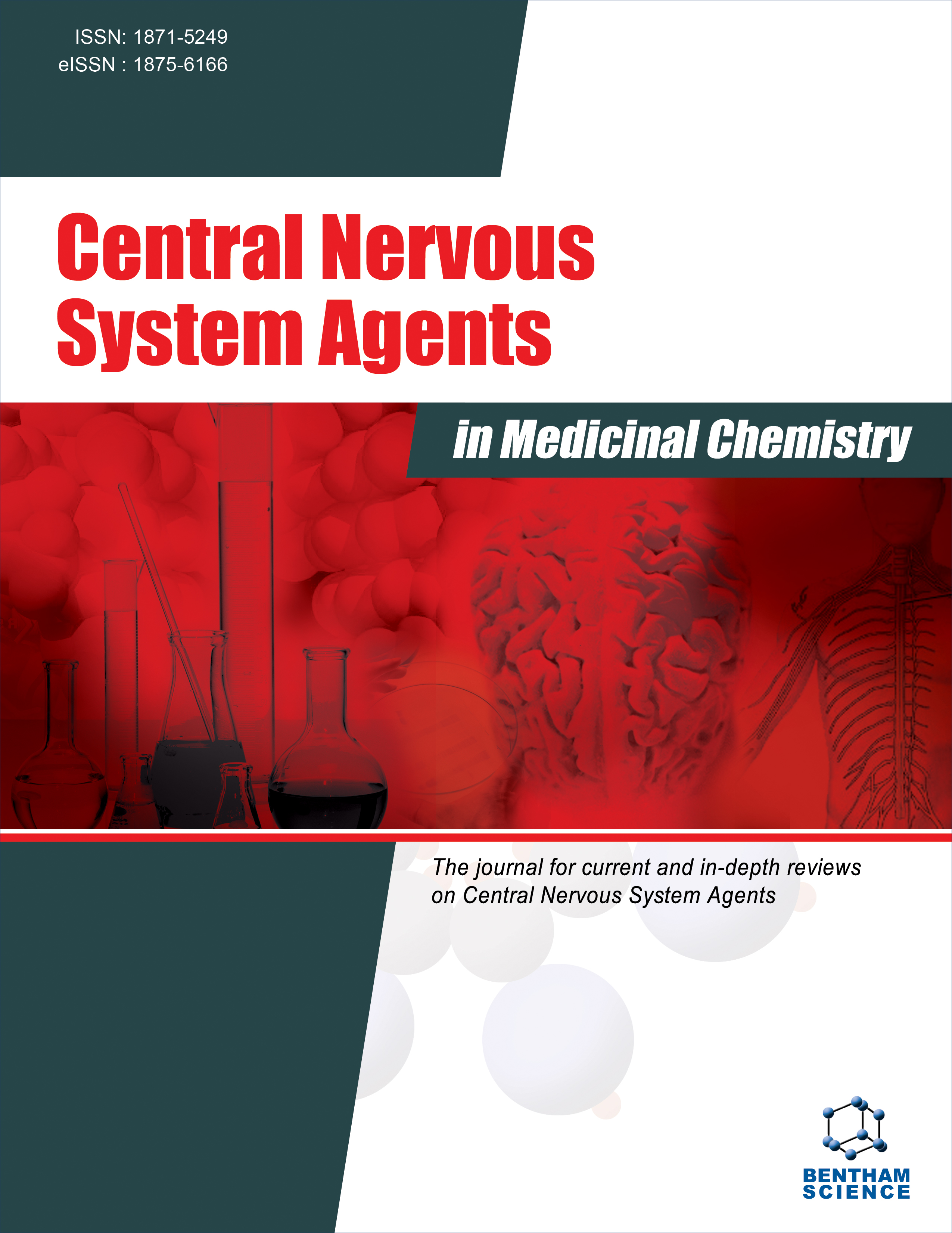- Home
- A-Z Publications
- Central Nervous System Agents in Medicinal Chemistry (Formerly Current Medicinal Chemistry - Central Nervous System Agents)
- Previous Issues
- Volume 15, Issue 2, 2015
Central Nervous System Agents in Medicinal Chemistry (Formerly Current Medicinal Chemistry - Central Nervous System Agents) - Volume 15, Issue 2, 2015
Volume 15, Issue 2, 2015
-
-
Crude Venom from Nematocysts of the Jellyfish Pelagia noctiluca as a Tool to Study Cell Physiology
More LessAuthors: Rossana Morabito, Giuseppina L. Spada, Rosalia Crupi, Emanuela Esposito and Angela MarinoMarine animals represent a source of novel bioactive compounds considered as a good research model, whose mechanism of action is intriguing and still under debate. Among stinging animals, Cnidarians differentiated highly specialized cells, termed nematocytes, containing a capsule fluid with toxins and an inverted tubule, synergistically responsible for mechanisms of defence and predation. Such compounds include protei Read More
-
-
-
Neurotoxic and Neuroactive Compounds from Cnidaria: Five Decades of Research….and More
More LessAuthors: Gian L. Mariottini, Gaido Bonello, Elisabetta Giacco and Luigi PaneCnidarians are numbered among the most venomous organisms. Their venoms are contained in intracellular capsules, nematocysts, which inject the content into preys/attackers through an eversion system resembling a syringe needle. Several cnidarian venoms have activity against the nervous system, being neurotoxic, or affect other systems whose functioning is under nerve control. Besides direct damage to nerve cel Read More
-
-
-
Scyphomedusae of the Mediterranean: State of the Art and Future Perspectives
More LessAuthors: Isabella D’Ambra and Alenka MalejScyphomedusae (Phylum Cnidaria, Class Scyphozoa) are perceived as a nuisance due to their sudden outbreaks that negatively affect human activities (particularly tourism and fisheries) mainly because of their stings. A brief review of the history of scyphozoan blooms in the Mediterranean and updated information available after 2010 point to an increase in scyphozoan outbreaks. Whilst the negative effects on public health, Read More
-
-
-
Activity of Drugs and Components of Natural Origin in the Severe Myoclonic Epilepsy of Infancy (Dravet Syndrome)
More LessAuthors: Agostino Berio and Attilia PiazziThe sea anemones (Cnidaria) produce neurotoxins, polypeptides active on voltage-gated sodium channels, which induce a non-inactivating condition, with consequent seizures and paralysis in zebrafish (Danio rerio). In humans, severe myoclonic epilepsy of infancy (SMEI) is due to SCN1A gene mutation, which causes a non-inactivating sodium channels condition with seizures. Some symptoms, such as age of first seizure, r Read More
-
-
-
Biological Activities of QIAPI 1 as a Melanin Precursor and Its Therapeutic Effects in Wistar Rats Exposed to Arsenic Poisoning
More LessThe chemical process initiated by QIAPI 1 has been deemed to be the most important biological reaction associated with human photosynthesis, and possibly neuroprotective effects under various inflammatory events. However, the detailed biological activities of QIAPI 1 as a melanin precursor are still unknown. In the present work, cytotoxicity test was done by MTT assay to determine cell viability of various cell lines ( Read More
-
-
-
Parkinson’s Disease and Alpha-Synucleinopathies: from Arising Pathways to Therapeutic Challenge
More LessAuthors: Fabiana Miraglia, Laura Betti, Lionella Palego and Gino GiannacciniParkinson’s Disease (PD) and alpha synucleinopathies are multifactorial disorders, which manifest through motor symptoms and non-motor symptoms involving the Central Nervous System (CNS), the Peripheral Nervous System (PNS) and, recently, also the Enteric Nervous System (ENS). The typical hallmarks of alpha synucleinopathies are proteinaceous inclusions of alpha synuclein (αS). In PD they are known as Lewy Bod Read More
-
-
-
Ocular Biomarkers of Alzheimer’s Disease
More LessAuthors: George R. Heaton, Benjamin M. Davis, Lisa A. Turner and Maria F. CordeiroAlzheimer’s disease (AD) is a devastating neurodegenerative disease characterised clinically by a progressive decline in executive functions, memory and cognition. Classic neuropathological hallmarks of AD include intracellular hyper-phosphorylated tau protein which forms neurofibrillary tangles (NFT), and extracellular deposits of amyloid β (Aβ) protein, the primary constituent of senile plaques (SP). The gradual process o Read More
-
-
-
Oligonucleotide Aptamers for Glioma Targeting: An Update
More LessAuthors: Simona Camorani and Laura CerchiaMalignant glioma is the most prevalent and lethal primary brain tumor. Due to molecular heterogeneity and organ-specific clinical manifestations, it is essential to improve glioma treatment by shifting from conventional cytotoxic chemotherapy to more targeted therapies. Hence, innovative approaches based on ligands able to specifically detect and measure mutated proteins associated to a specific tumor phenotype are ne Read More
-
Volumes & issues
-
Volume 25 (2025)
-
Volume 24 (2024)
-
Volume 23 (2023)
-
Volume 22 (2022)
-
Volume 21 (2021)
-
Volume 20 (2020)
-
Volume 19 (2019)
-
Volume 18 (2018)
-
Volume 17 (2017)
-
Volume 16 (2016)
-
Volume 15 (2015)
-
Volume 14 (2014)
-
Volume 13 (2013)
-
Volume 12 (2012)
-
Volume 11 (2011)
-
Volume 10 (2010)
-
Volume 9 (2009)
-
Volume 8 (2008)
-
Volume 7 (2007)
-
Volume 6 (2006)
Most Read This Month
Article
content/journals/cnsamc
Journal
10
5
false
en


